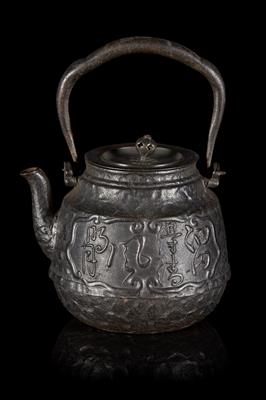Shibuicki Kettle
Download media
Object number03630
TitleShibuicki Kettle
DescriptionThis magnificent cast-iron kettle is a Japanese tetsubin, made in the 19th century. It was an everyday object used to heat water over a charcoal fire as part of the traditional tea making ceremony. It is believed that not only does the iron kettle enrich the water when it is heated, but it also smooths the taste of the water. This makes it perfect for brewing delicate Japanese teas.
Tetsubin became popular from the 16th century with the introduction of whole leaf tea (sencha) from China – this was less formal and therefore easier to use than the traditional powdered matcha. They were often elaborately decorated either with an inlay of copper, gold or silver, or with cast-iron decoration in high relief – as you see here.
While a very practical object, it is also a thing of beauty – the tiny handle on the lid resembles a lotus flower. In eastern religions the lotus is a symbol of purity, enlightenment, self-regeneration and rebirth. There are decorative panels on each side of the kettle too: one side features a poem in Japanese sosho (cursive) script, the other illustrates the story with a figure (perhaps two) viewing the cherry blossom. This Japanese tradition, called hanami, happens every spring and can be traced back at least a thousand years.
Production placeJapan,
Object nameKettle
MaterialIron
TechniqueCast
Dimensions
whole Length: 135 mm
whole 110 mm
whole Height: 220 mm
whole 110 mm
whole Height: 220 mm



